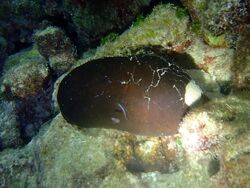Biology:Actinopyga lecanora
| Actinopyga lecanora | |
|---|---|

| |
| Scientific classification | |
| Domain: | Eukaryota |
| Kingdom: | Animalia |
| Phylum: | Echinodermata |
| Class: | Holothuroidea |
| Order: | Holothuriida |
| Family: | Holothuriidae |
| Genus: | Actinopyga |
| Species: | A. lecanora
|
| Binomial name | |
| Actinopyga lecanora | |
| Synonyms[2] | |
| |
Actinopyga lecanora, commonly known as the white-bottomed sea cucumber or stonefish,[3] is a species of sea cucumber in the family Holothuriidae. It is native to the tropical Western Indo-Pacific region and is harvested for food.
Description
Actinopyga lecanora grows to a length of about 250 mm (10 in). The top and bottom of the sea cucumber is a mottled tan-orange colour, and the anus is surrounded with a white ring, lending the sea cucumber its common name.[3]
Distribution and habitat
Actinopyga lecanora is found off the coasts of Asia and East Africa, in the tropical Indian Ocean and the western Pacific Ocean. Its range extends from Kenya and Madagascar to the west, to Papua New Guinea, the Philippines, Taiwan, and other island groups in the western Pacific. It is considered rare in the Taiping Islands and Taiwan. It is nocturnal and typically found on forereef slopes, at depths between 0 and 23 m (0 and 80 ft), and prefers microhabitat with complex topography.[1][3][4]
Status
This species is harvested commercially for food and traditional medicine in some parts of its range, and is of medium commercial importance. It is used in the production of bêche-de-mer in 13 different countries in the Western Central Pacific. In Papua New Guinea, it is subject to a minimum size limit of 15 cm (6 in) if fresh and 15 cm (6 in) if dry, as well as a designated fishing season between January 16 and September 30 to prevent overfishing.[1] The IUCN lists its conservation status as data deficient.[1]
Aquaculture and early development
This species has not been cultured at industrial scales, but a technique to produce its juvenile has been developed.[5] This species has large ovary over 300 μm in diameter and lecithotrophic. Its planktonic larva rapidly settles into the benthic phase in 4-8 days after fertilization.
References
- ↑ 1.0 1.1 1.2 1.3 Conand, C.; Gamboa, R.; Purcell, S. (2013). "Actinopyga lecanora". IUCN Red List of Threatened Species 2013: e.T180266A1608301. doi:10.2305/IUCN.UK.2013-1.RLTS.T180266A1608301.en. https://www.iucnredlist.org/species/180266/1608301. Retrieved 20 November 2021.
- ↑ Cite error: Invalid
<ref>tag; no text was provided for refs namedITIS - ↑ 3.0 3.1 3.2 "Actinopyga caerulea, white-bottomed sea cucumber". SeaLifeBase. https://www.sealifebase.ca/summary/Actinopyga-lecanora.html.
- ↑ Tanita, I.; Hirohavi, E. B.; Diau, B. A.; Masaki, K.; Komatsu, T.; Ramofafia, C. (2022), "Macro- and microhabitat use patterns of holothurians in Buena Vista, Nggela, Solomon Islands: rock climber and bottom crawler species", Marine Ecology Progress Series 687: 79-93, doi:10.3354/meps14008
- ↑ Tanita, I.; Sanda, T.; Iwasaki, T.; Ohno, K.; Yoshikuni, M. (2023), "Artificial rearing of Actinopyga lecanora (Holothuroidea: Holothuriida) with spawning induction using relaxin: Lecithotrophic short larval period", Aquaculture 567: 739226, doi:10.1016/j.aquaculture.2022.739226
Wikidata ☰ Q2106936 entry
 |


